
Depression Glass is glassware that was made during the Depression Era of the 1920s through the early 1940s. During this time period, glass companies began using automated glass-making equipment that could mass-produce molded glassware inexpensively.
The 7 main companies that manufactured Depression Glass were:
- Federal Glass Company
- Hazel-Atlas Glass Company
- Hocking Glass Company
- Indiana Glass Company
- Jeannette Glass Company
- Macbeth-Evans Glass Company
- U.S. Glass Company
Hocking Glass Company (later to become Anchor Hocking) produced the most Depression Glass patterns; at least 31 patterns are known and documented. The full list of Hocking Depression Glass patterns can be seen further down in this article.
In addition to the 7 large manufacturers above, some other companies that produced Depression Glass were:
- Belmont Tumbler Company
- Central Glass Works
- Dell Glass Company
- Diamond Glass-Ware Company
- Dominion Glass Company Limited
- Economy Glass Company
- Fenton
- Fostoria Glass Company
- Imperial Glass Company
- Lancaster Glass Company
- L. E. Smith Glass Company
- Liberty Works
- Lotus Glass Company
- McKee Glass Company
- New Martinsville Glass Manufacturers
- Paden City Glass Company
- Westmoreland Glass Company
*Please note that there is some discrepancy among historians and reference books as to which glass patterns should officially be considered Depression glass patterns. More information is included at the bottom of this article.
Continue reading for additional information on the major manufacturers of Depression Glass as well as the most popular patterns produced by each company.
Federal Glass Company
Federal Glass Company began producing Depression Glass in 1927. Federal produced at least 14 documented patterns of Depression Glass, mainly in green, crystal, pink, and amber.
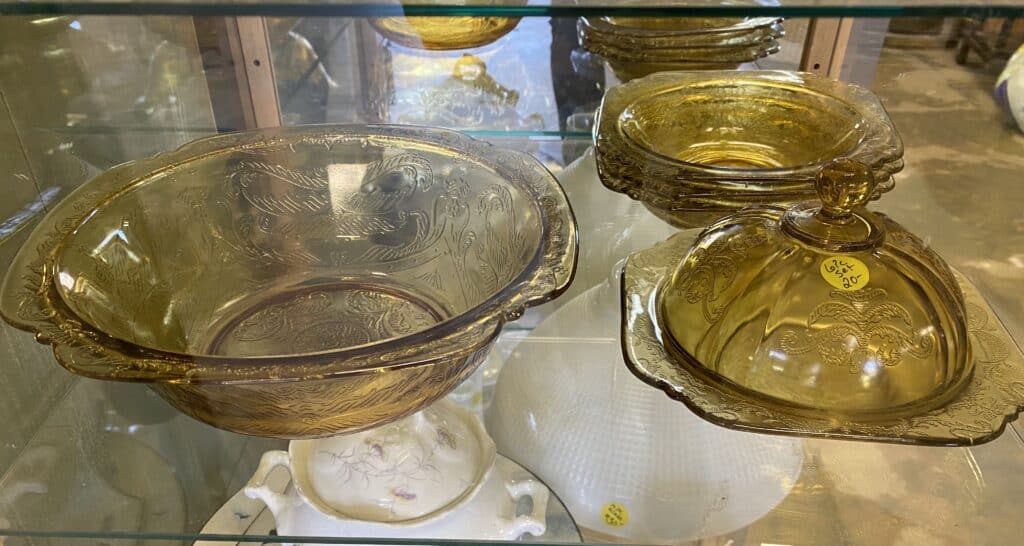
Below are the known Federal Glass Depression Glass Patterns along with the colors they were produced in.
- Colonial Fluted aka Rope (Green and Crystal)
- Columbia (Crystal, Pink, Ruby flashed)
- Diana (Pink, Amber, Crystal, Green, Red, frosted with Red trim, Crystal tumblers w colored stripes)
- Georgian Lovebirds (Green, Crystal, Amber)
- Madrid (Amber, Green, Pink, Blue, Crystal)
- Mayfair (Green, Amber, Crystal) not to be confused with Hocking’s Mayfair
- Normandie aka Bouquet and Lattice (Amber, Pink, Iridescent)
- Parrot aka Sylvan (Green, Amber, Blue, Crystal)
- Patrician aka spoke (Green, Pink, Amber, Crystal)
- Pebble Optic aka Raindrops (Green, Crystal)
- Rosemary aka Dutch Rose (Amber, Green, Pink)
- Sharon aka Cabbage Rose (Green, Pink, Amber, Crystal)
- Spiral (Pink, Green, and Crystal)
- Thumbprint (Green, Crystal)
For more information, check out our full guide to Federal Glass Company Depression Patterns.
Hazel-Atlas Glass Company
The Hazel-Atlas Glass Company began producing Depression Glass in 1930 and produced at least 16 known patterns. Hazel-Atlas expanded their colors beyond the popular pink, crystal, and green of the time and produced several of their patterns in cobalt blue that they called “Ritz Blue” (my personal favorite), topaz, amethyst, black, and more.
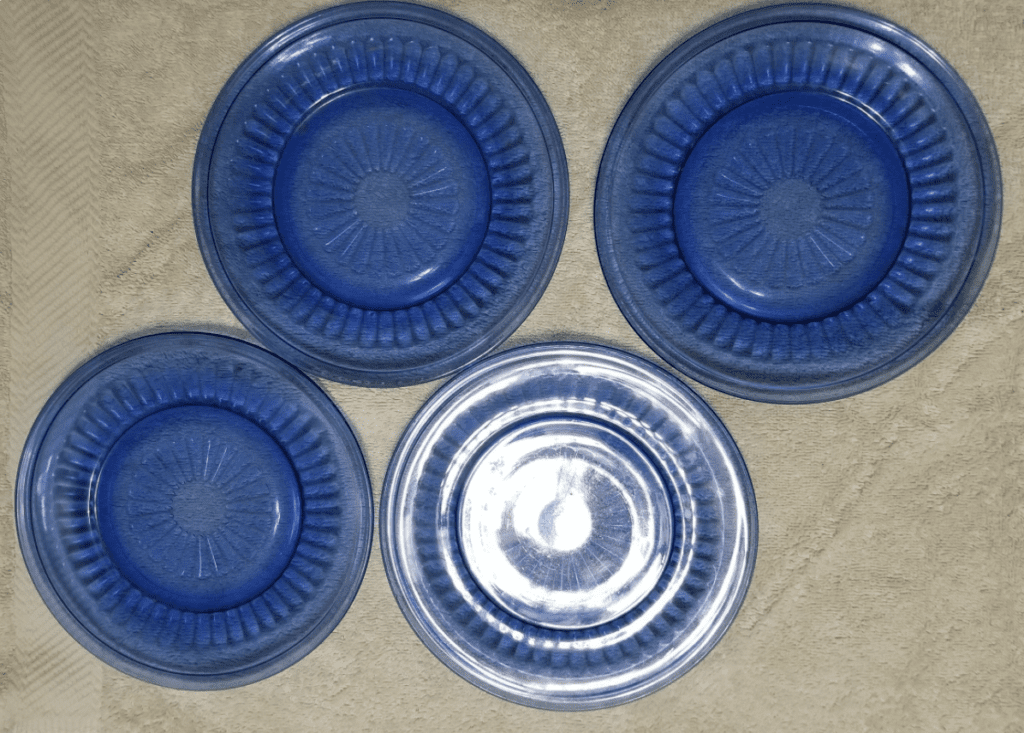
Hazel-Atlas also created an opaque glass called Platonite that they produced in white and many other colors.
Below are the known Hazel-Atlas Depression Glass Patterns along with the colors they were produced in.
- Aurora (Cobalt and Pink, Other)
- Cloverleaf (Green, Topaz, Black, Pink)
- Colonial Block (Pink, Green, White, Crystal, Black)
- Florentine No. 1 aka Old Florentine, Poppy No. 1 (Green, Yellow, Pink, Cobalt, Crystal, Fired-on Green)
- Florentine No. 2 aka Poppy No. 2. (Green, Yellow, Pink, Crystal, Cobalt, Ice Blue, Amber)
- Fruits (Green, Pink, Crystal, and iridescent)
- Moderntone (Cobalt, Amethyst Purple, Pink, Green, Platonite – multiple colors)
- New Century (Green, Amethyst, Pink, Cobalt, Crystal)
- Newport aka Hairpin (Cobalt, Amethyst, Pink, Fired-on colors
- Ovide (Green, Black, Pink, Amber, decorated multi)
- Ribbon (Green, Crystal, Black, Pink)
- Spiral (Green)
- Spiral Optic (Green, Pink, Cobalt Blue)
- Starlight (Pink, Cobalt, White, Crystal)
- White Ship aka Ships aka Sailboat (Cobalt Blue glass with White details)
Hocking Glass Company
Hocking Glass Company (which became Anchor Hocking in 1937) began producing Depression Glass in 1927. Hocking produced the most known Depression Glass patterns.

Below are the 31 known Depression Glass patterns produced by Hocking Glass Company.
- Banded Spiral (Green and Pink)
- Block Optic (Green, Pink, Topaz, Amber, Crystal)
- Bubble aka Provincial or Bullseye Provincial (Blue, Ruby Flash, Green, Red, White, Crystal, Amber, Iridescent, Black, Pink, Jadeite, dark Blue, Yellow)
- Cameo aka Ballerina aka Dancing Girl (Green, topaz, Pink, Crystal) reproduced in Cobalt Blue
- Circle (Green, Pink, Crystal)
- Colonial aka Knife and Fork (Pink, Green, Crystal, Ruby, White)
- Coronation aka Saxon (Pink, Ruby, Green, Crystal)
- Fire-King Philbe (Blue, Crystal, Green, Pink)
- Fortune (Pink, Crystal)
- Hobnail (Pink, Crystal, Colored trimmed)
- Lace Edge aka Old Colony aka Open Lace (Pink, Green, White, Fired-on Pink, Crystal)
- Lake Como (White glass called Vitrock with Blue ornamentation applied)
- Manhattan aka Horizontal Ribbed (Crystal, Pink, Ruby, iridized, Jadeite, forest Green)
- Mayfair aka Open Rose (Pink, Blue, Green, Yellow)
- Miss America aka Diamond Pattern (Pink, Crystal, Green, Ruby, ice Blue, Jadeite) Any Cobalt is reproduction
- Moonstone (produced post 1940 and therefore technically not depression glass)
- Old Café’ (Pink, Ruby, Crystal)
- Oyster and Pearl (Ruby, Pink, Crystal, other and Fired-on colors)
- Pillar Optic (Green, Pink, Crystal)
- Princess (Pink, Green, topaz, apricot)
- Queen Mary aka Vertical Ribbed aka Prismatic Line (Pink, Crystal, Royal Ruby, Forest Green, Yellow, Amethyst)
- Ring aka Banded Rings (Crystal with colors, Green, other?)
- Roulette aka Many Windows (Green, Pink, Crystal)
- Roxana (Yellow, White, Crystal)
- Royal Lace (Cobalt Blue, Green, Pink, Crystal, Amethyst, Iridized Pink)
- Royal Ruby (Ruby Red)
- Sandwich (Crystal, forest Green, Amber)
- Spiral (Green, Pink, and iridized Crystal)
- Spiral Optic (Crystal)
- Vitrock aka Flower Rim (White, Fired-on colors)
- Waterford aka Waffle (Pink, Crystal, Amber, forest Green, other?)
Indiana Glass Company
Indiana Glass Company began producing Depression Glass in 1923, and the NDGA considers Indiana’s Avocado pattern to be the first “Depression Glass” pattern ever produced.
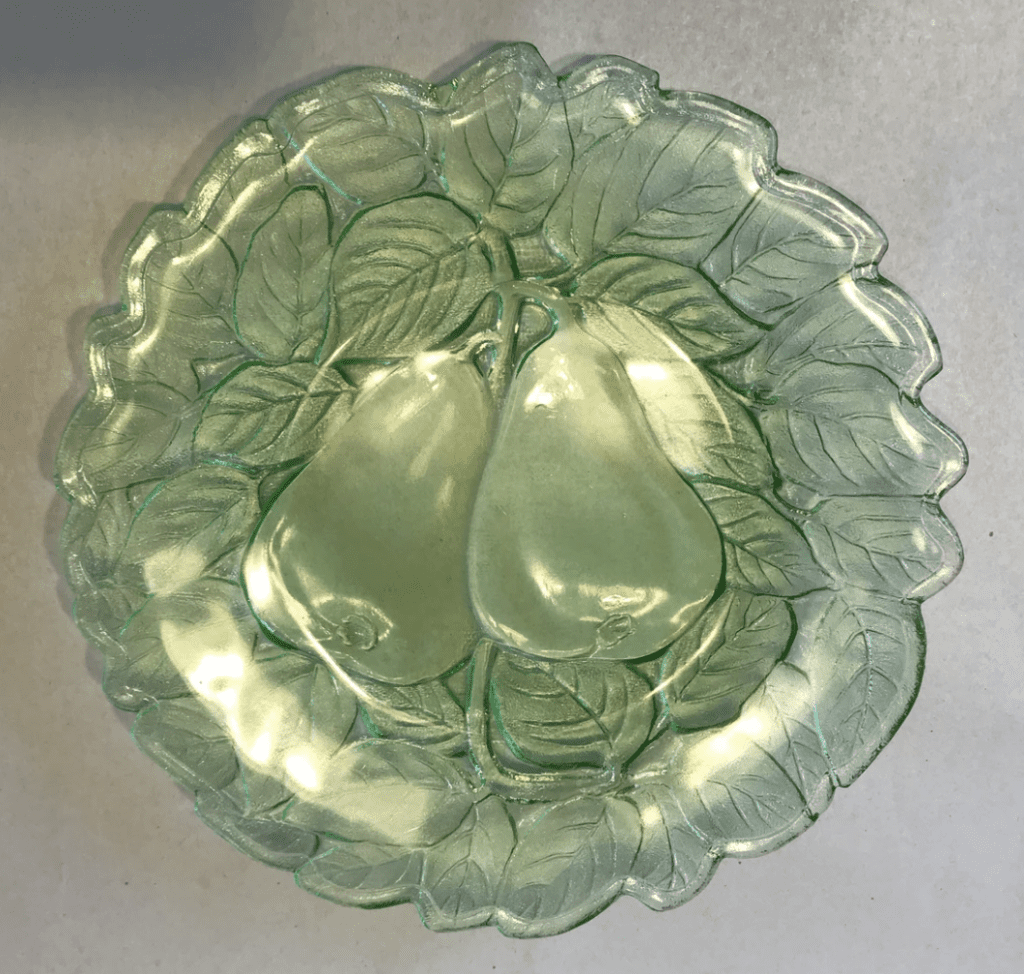
Indiana Glass produced the following 15 known Depression Glass patterns:
- Avocado (Green, Pink, Crystal) – Note: This was reproduced in Amethyst, Blue, frosted Pink, Red, Yellow, darker Green, Pink with an orange tint, frosted Green, milk glass
- Christmas Candy – (Terrace Green, Crystal)
- Daisy (Crystal, Green, Amber, Fired on Red)
- Horseshoe (Green, Yellow, Pink)
- Indiana Custard aka Flower and Leaf Band (French Ivory) glass with the visual qualities of china
- Lily Pons & Pebble Leaf (Green, Crystal, Red)
- Lorain (Green, Yellow, Crystal)
- Old English aka Threading (Amber, Green, Crystal, Pink)
- Pineapple and Floral (Crystal, Fired-on, Red and Amber, other?)
- Pretzel (Crystal, Fired-on Blue, Fired-on Pink)
- Pyramid (Green, Pink, Yellow, Crystal)
- Sandwich / Tiara (Crystal, Teal, Red, Pink, and Green)
- Spiral Optic (Green, Fired-on colors)
- Tearoom (Green, Pink, Crystal, Amber)
- Vernon (Green, Yellow, Crystal)
Jeannette Glass Company
Jeannette Glass Company began producing Depression Glass in 1928. Jeannette was one of the only companies to produce Depression Glass in teal, which they called Ultramarine. They also produced several of their patterns in Delphite, which is an opaque powder blue color.
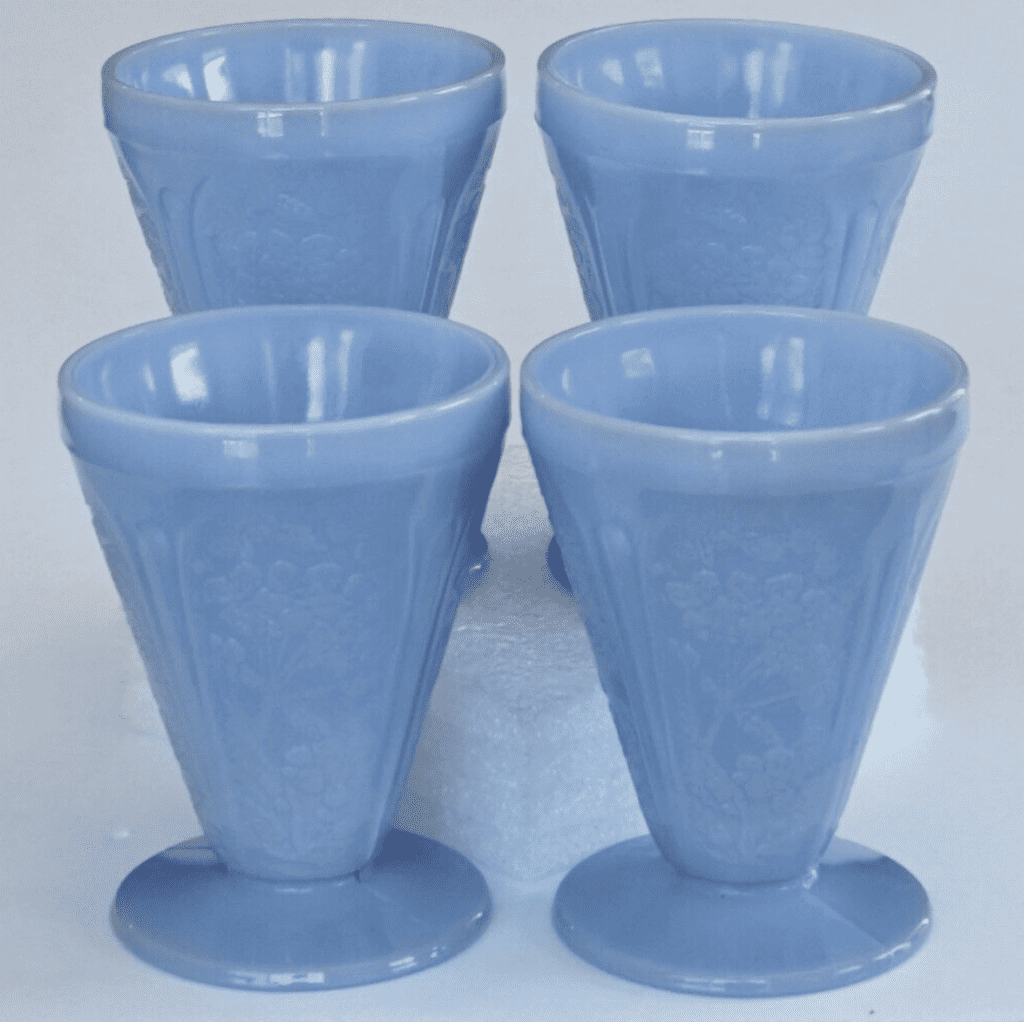
Jeannette Glass Company produced the following known 16 Depression Glass patterns:
- Adam (Pink and Green, certain items in Delphite, Crystal, Yellow, iridescent Pink, and Satinized Pink)
- Cherry Blossom (Pink, Green, Delphite, Yellow, Crystal, Jadeite)
- Cube aka Cubist (Pink, Green Ultramarine, Amber, White, Crystal
- Diamond Cut aka Anniversary (Pink, Crystal, Amberescense (Amber iridescent)
- Doric (Pink, Green, Delphite, Ultramarine, Light Blue, Yellow)
- Doric and Pansy (Ultramarine, Pink, Crystal)
- Floral aka Poinsettia (Pink, Green, Delphite)
- Hex Optic aka Honeycomb (Pink, Green, iridescent, Ultramarine)
- Homespun aka Fine Rib (Pink, Crystal)
- Iris aka Iris and Herringbone – some conflicting information, some reference guides said it was produced in 1928- 1932 and then again post-1950. Mauzy’s Guide states that they believe it wasn’t produced originally until 1943
- Sierra aka Pinwheel (Pink, Green, Ultramarine)
- Spiral Optic (Green, Iridescent, Pink)
- Sunburst (Crystal, Iridized)
- Sunflower (Green, Pink, Opaque, Ultramarine, Delphite, Yellow, caramel)
- Swirl aka Petal Swirl (Ultra-marine, Pink, Amber, Delphite)
- Windsor (Pink, Green, Crystal, Delphite, others)
Macbeth-Evans Glass Company
Macbeth-Evans made some interesting color variations to their Depression Glass. They created an opaque white with a bluish tint that was more translucent than milk glass, and they called this Monax. They made a similar ivory opaque color that they called Cremax.
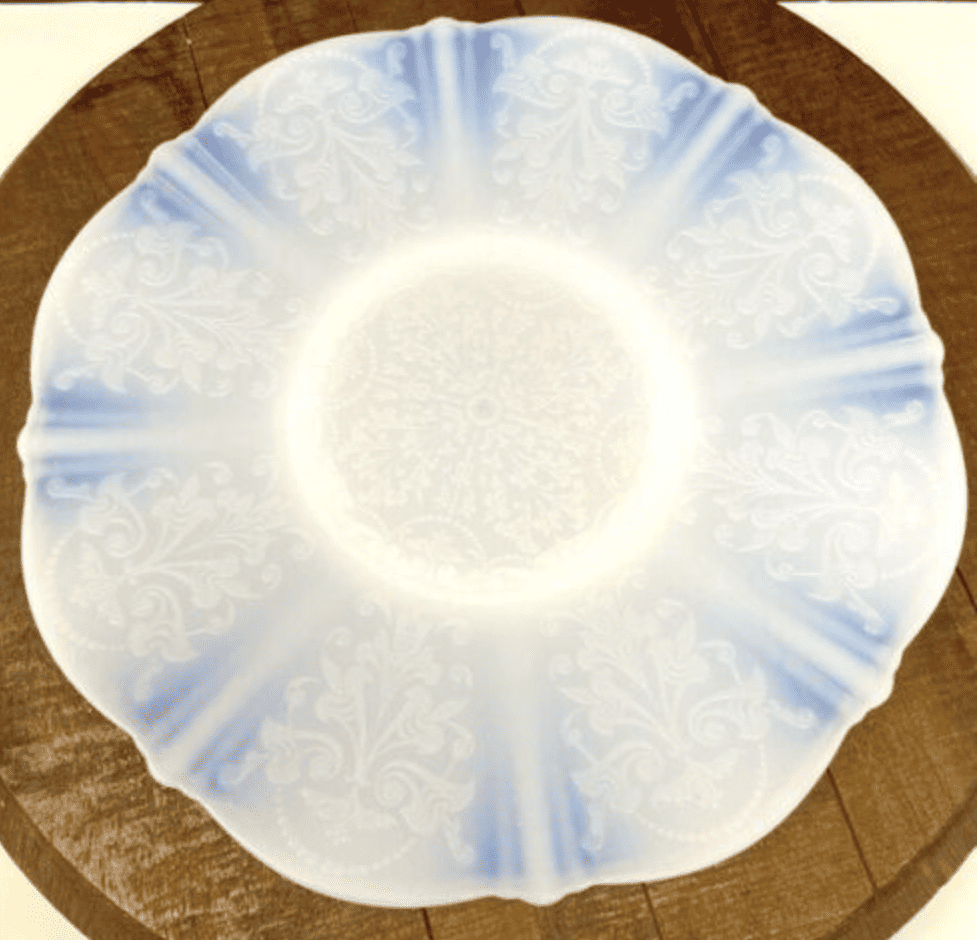
Macbeth-Evans Glass Company produced the following 8 known Depression Glass patterns.
- American Sweetheart (Pink, Monax, Red, Blue, Crystal, Cremax)
- Chinex Classic- Unlike most depression glass due to the coloring and china look – floral and other designs
- Cremax (multi)
- Crown – Pyrex collab? (Turquoise)
- Dogwood aka Apple Blossom aka Wild Rose (Pink, Green, Monax, Cremax)
- Petalware (Monax, many Fired-on colors, and decorations)
- “S” Pattern aka Stippled Rose Band (topaz, Crystal, Crystal with variations, Fired-on Red, Monax, Amber, others)
- Thistle (Pink, Green)
U.S. Glass Company
U.S. Glass Company has a long history that includes several mergers. The Tiffin factory located in Tiffin, Ohio, was one of the few factories that managed to survive the 1930s. Although the official name of the company remained U.S. Glass Company during the Depression Era, household items produced by U.S. Glass after September 1927 were labeled “TIFFIN” on a shield with a capital “T. (Source)

U.S. Glass Company produced the following 9 known Depression Glass patterns.
- Aunt Polly (Blue, Green, iridescent)
- Cherryberry (Pink, Green, Crystal, iridescent
- Floral and Diamond Band (Pink, Green, Crystal, iridescent)
- Flower Garden with Butterflies aka Butterflies and Roses (Amber, black, black Amethyst, Blue, Blue-Green, canary Yellow, Crystal, Green, and Pink)
- Primo aka Paneled Aster (Yellow, Green, black)
- Spiral Optic (dark Green, light Green, other?)
- Strawberry (Pink, Green, Crystal, iridescent)
- Tendril (Green, Pink)
- U.S. Swirl (Green, Pink, Crystal, iridescent)
Other Depression Glass Manufacturers and their Patterns:
Belmont Tumbler Company was believed to produce the following known Depression Glass patterns, although many of their records were destroyed in a fire:
- Bowknot (unconfirmed)
- Rose Cameo
Central Glass Works produced the following known Depression Glass patterns:
- Frances
Dell Glass Company produced the following known Depression Glass patterns:
- Tulip
Diamond Glass-Ware Company produced the following known Depression Glass patterns:
- Victory
Dominion Glass Company Limited produced the following known Depression Glass patterns:
- Canadian Swirl
- Hiawatha
Economy Glass Company produced the following known Depression Glass patterns:
- Round Robin
Fenton produced the following known Depression Glass patterns:
- Lincoln Inn
Fostoria Glass Company produced the following known Depression Glass patterns:
- Spiral Optic
Imperial Glass Company produced the following known Depression Glass patterns:
- Beaded Block
- Diamond Quilted aka Flat Diamond
- Katy aka Laced Edge
- Twisted Optic
Lancaster Glass Company produced the following known Depression Glass patterns:
- Jubilee
- Patrick
L. E. Smith Glass Company produced the following known Depression Glass patterns:
- Mt. Pleasant
- Romanesque
Liberty Works produced the following known Depression Glass patterns:
- American Pioneer
Lotus Glass Company produced the following known Depression Glass patterns:
- La Furiste
McKee Glass Company produced the following known Depression Glass patterns:
- Laurel
- Rock Crystal Flower
New Martinsville Glass Manufacturing Company produced the following known Depression Glass patterns:
- Moondrops
- Radiance
Paden City Glass Company produced the following known Depression Glass patterns:
- Crow’s Foot
- Cupid
- Delilah Bird
- Nora Bird
- Orchid
- Peacock and Rose
- Rena
Westmoreland Glass Company produced the following known Depression Glass patterns:
- Della Robbia
- English Hobnail
Discrepancies in Depression Glass Definitions
In this very informative paper by Joyce Krupey, she states that “there is no absolute delineation of what is or is not Depression Glass”. That’s why there are some discrepancies regarding certain glass patterns and their inclusion in the major Depression Glass reference guides.
Joyce expands on Marian Klamin’s definition of Depression Glass as follows:
Useful glassware produced in a variety of colors during the period that roughly dates between 1920 and 1940. It was the first mass produced glassware, made by totally by machine, distributed nationally and sold cheaply. The glass was stylish, highly popular, pretty, and plentiful. It was poor quality glass made in interesting patterns and colors.
Joyce Krupey, NDGA.net paper
Joyce notes that certain glass patterns, such as English Hobnail by Westmoreland Glass Company, were “handmade and hand-finished in a better quality glass than most Depression Glass”, and were “not produced by the totally mechanized methods that generally define Depression Glass.
The distinction came to be made by Gene Florence that high-quality or hand-blown glassware, though it may have been produced in the Depression Era, should be referred to as “Elegant Glass” instead of “Depression Glass. (Source)
Another discrepancy that I’d like to mention is that many Depression Glass reference guides, including two that I used for this article, list several patterns that began being produced in 1940 and after. I tend to agree with most of the articles and definitions of the NDGA that a boundary of 1939 should be set on Depression Glass. That is to say that if a pattern of glass began production in 1940 or after, it should not be considered Depression Glass.
However, it should be noted that a few of these patterns made in the 1940s and even into the 1950s, such as Jeannette’s Shell Pink Pattern, were produced by the same molds used to create Depression Glass. But for the sake of this article, I have not included any patterns that began production past 1939.
I believe the above statements are what lead to the discrepancies among the NDGA and multiple reference guides. Please feel free to contact me with any corrections or additional information.
SOURCES:
Mauzy’s Depression Glass Guide

